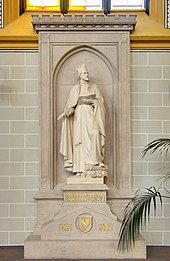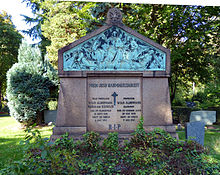Wilhelm Albermann

Wilhelm Albermann (born May 28, 1835 in Werden an der Ruhr ; † August 9, 1913 in Cologne ; full name: Johann Friedrich Wilhelm Albermann ) was a German sculptor .
Live and act

Albermann was the son of a master carpenter . He attended the Rector's School in Werden until he was 16 and then completed an apprenticeship as a wood sculptor in Elberfeld . In 1855 he was called up to serve in the military in Berlin and served in the 2nd Guards Grenadier Regiment. His company commander recognized Albermann's artistic talent and allowed him to attend the Berlin Art Academy while on duty and in uniform . During this time Albermann joined the Catholic Reading Association, the first student corporation of the KV , now K.St.V. Askania-Burgundia .
Albermann then initially worked for his teachers Hugo Hagen and August Fischer . In 1864 he became a soldier in the war against Denmark and then went back to Cologne in 1865. There he worked as a freelance sculptor. At the instigation of the city of Cologne and the Cologne district government , he founded a commercial drawing school in 1871 , to which he remained connected as a teacher and director until 1896. From 1893 to 1900 he was a city councilor in Cologne. In 1902 he was awarded the title of professor.
Albermann left an extraordinarily extensive sculptural work. The statues of Ferdinand Franz Wallraf and Johann Heinrich Richartz , which are in front of the Museum of Applied Arts in Cologne, come from him. Further works include the Jan-von-Werth -Brunnen on the Alter Markt and the Hermann-Joseph-Brunnen on the Waidmarkt. His building sculptures adorn numerous Cologne private houses and monumental buildings in the Rhineland, and he created altars, figures of the Madonna and saints for churches. Wilhelm Albermann found his final resting place in the Melaten cemetery (Lit L., between Lit Q. and the Wall). About twenty tombs are known that were created in his studio for distinguished Cologne families and also erected there; not all of them are preserved today.
plant
Public monuments, fountains, sculptures
- Aachen
- 1888: sculptural decoration of the facade of the Villa Cassalette
- Dingelstädt ( Klüschen Hagis )
- 1907–1910 Stone sand figure Immaculata
- Düren
- Mount of Olives in the Madonna's House (completed posthumously on September 20, 1913)
- Dusseldorf
- Kunsthalle : 1880–1881 four sandstone figures of caryatids , put up again in 1967 after the hall was demolished in the 1960s to the side of the newly built hall
- Eschweiler
- Anthony statue at the School of Our Lady
- eat
- Kettwig district
- War memorial for the fallen in the wars of 1866 and 1870/1871 with statues of Kaiser Wilhelm I , Otto von Bismarck and Field Marshal Helmuth von Moltke
- District Werden
- three statues on the Königsbrücke : Kaiser Wilhelm I, Otto von Bismarck, Helmuth von Moltke (preserved in a different location.)
- Statue of Emperor Friedrich III. (receive)
- Kettwig district
-
Hilden
- Statue of Kaiser Wilhelm I on the market (destroyed)
- Bismarck fountain on the market (destroyed)
- Cologne
- Seated portrait of Ferdinand Franz Wallraf
- Seated portrait of Johann Heinrich Richartz
- Grave monument for Ferdinand Franz Wallraf and Johann Heinrich Richartz in the Melatenfriedhof (destroyed in the war)
- Portrait medallion (bronze), burial site Hermann Otto Pflaume , Melaten-Friedhof Cologne (hallway 70 a) .
- Jan-von-Werth fountain in the old market (preserved)
- Hermann Joseph Fountain on the Waidmarkt
- Krefeld
- Statue of Helmuth von Moltke
- Mönchengladbach
- Crucifixion group 1902 (destroyed in the war)
- High reliefs in the Stations of the Cross of the Moresnet-Chapelle pilgrimage site (in Moresnet-Chapelle (Eikschen); Belgium)
- 14 pictures of the stations of the cross at the Franciscan Church
-
Remagen
- Francis statue on Mount Apollinaris
-
Sinzig
- Statue of Friedrich Barbarossa
The statue of the Staufer emperor with a height of 4.5 meters was created on the occasion of the silver wedding of the Bungees in 1875. In 1951 the monument was moved to the park below the Catholic parish church of St. Peter.
- Statue of Friedrich Barbarossa
-
Solingen
- Figure of a blade smith on a fountain in the Alter Markt, created in 1895 and destroyed in 1944
- War memorial ( "Solingen to his heroic sons who fell for King and Fatherland in 1870–1871" ), ceremoniously unveiled on October 18, 1875. Torn down on November 30, 1955 for urban planning reasons; the metal parts have been scrapped.
- trier
- Statue Friedrich Spee , in the south aisle of the Jesuit Church
-
Viersen - addicts
- Circular war memorial for the fallen in the war of 1870/1871 on the Süchtelner Heights, relief portrait of Kaiser Wilhelm I, memorial plaques and corner stones with the battlefields
- Wuppertal
- War memorial on the Königsplatz (today Laurentiusplatz ) in front of the Laurentiuskirche in Elberfeld, inaugurated on July 30, 1881 (not preserved)
- Fairytale fountain in the Wuppertal Zoo district , 1897
gallery
literature
- Erwin Dickhoff: Essen heads. Who was what Richard Bracht, Essen 1985, ISBN 3-87034-037-1 , p. 3.
- Werner Schmidt: The sculptor Wilhelm Albermann. Life and work (= publications of the Cologne City Museum, Volume 3.) Cologne 2001, ISBN 3-927396-85-0 .
- Siegfried Koß in Siegfried Koß, Wolfgang Löhr (Hrsg.): Biographisches Lexikon des KV. 2nd part (= Revocatio historiae. Volume 3). SH-Verlag, Schernfeld 1993, ISBN 3-923621-98-1 , p. 15 f.
- P. Höveler: Professor Wilhelm Albermann. In: Academic monthly sheets . 1914.
- E. Trier, W. Weyres (Ed.): Art of the 19th century in the Rhineland. Volume IV. Schwann, Düsseldorf 1980, ISBN 3-590-30254-2 .
- Paul Kühn : Albermann, Wilhelm . In: Ulrich Thieme , Felix Becker (Hrsg.): General Lexicon of Fine Artists from Antiquity to the Present . Founded by Ulrich Thieme and Felix Becker. tape 1 : Aa – Antonio de Miraguel . Wilhelm Engelmann, Leipzig 1907, p. 184-185 ( Text Archive - Internet Archive ).
Web links
- Literature by and about Wilhelm Albermann in the catalog of the German National Library
Individual evidence
- ^ Josef Abt, Johann Ralf Beines, Celia Körber-Leupold: Melaten - Cologne graves and history. Greven, Cologne 1997, ISBN 3-7743-0305-3 , pp. 47, 161.
| personal data | |
|---|---|
| SURNAME | Albermann, Wilhelm |
| ALTERNATIVE NAMES | Albermann, Johann Friedrich Wilhelm (full name) |
| BRIEF DESCRIPTION | German sculptor |
| DATE OF BIRTH | May 28, 1835 |
| PLACE OF BIRTH | Be at the Ruhr |
| DATE OF DEATH | August 9, 1913 |
| Place of death | Cologne |







